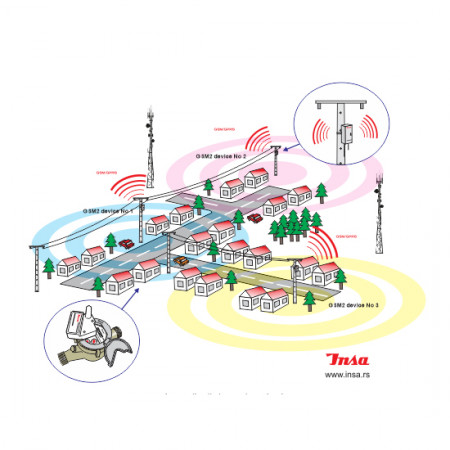About INSA ADO System for remote water meter reading
INSA ADO Remote reading system is used for remote reading of water meters, calorimeters, gas meters and other consumption measuring devices. The system uses radio transmission as a basic medium for communication with the devices and the system can also be connected to other media and networks such as Ethernet, USB, Bluetooth or mobile telephony.
Radio communication in the remote reading system operates at two bands. Unlicensed ISM (Industry-Science-Medicine) bands on 868MHz and 2.4GHz and 4 types of protocols are used. RF868 radio protocol (INSA), wM-Bus radio protocol and LoRA protocol are used on 868MHz band and radio protocol RF24 (INSA) is used on 2.4GHz band.
wM-Bus protocol (Wireless M-Bus) is a radio protocol on 868MHz band in compliance with EN 13757-4 European Standard. It is used for reading the measuring devices at distances up to 1km in open space. It is characterized by one way communication (T1 mode) and under certain conditions two way communication (T2 mode) when parameterizing the device. Factory settings of the ADO devices using the wM-Bus protocol ensure that the data packet is sent every 6 seconds, but the transmission time can be increased in order to reduce the device consumption or at user's request. The universal wM-Bus protocol enables compatibility and reading of INSA ADO devices parallel to other systems (e.g., electric meters or calorimeters) of other manufacturers.
The RF868 protocol is designed for longer distances and up to 1 km in open space. It is intended for wireless remote reading of measuring devices (water meters, gas meters...) using the radio frequency of 868MHz and two way semi duplex communication. This protocol provides efficient data transmission via radio channel between application levels of the devices and software with different application levels. The RF868 protocol communication is based on the query-response principle. The device that starts the communication and sends the query is called the "master" device, while the responding device is called the "slave" device. Usually, the master device is a modem or a concentrator, while the slave device is usually a measuring device. There is also a special device, the repeater, which is located between the master and the slave devices and operates on the "store and forward" principle at RF868 protocol level.
The RF24 protocol is designed for shorter distances up to 10 m from the manhole and up to 50 m in open space. This protocol is used as an auxiliary protocol, as a wire substitute, to connect the sensor and data concentration with multiple sensors where high speed and resolution of reading are required.
LoRA protocol (Long Range) is a relatively new standard characterized by extremely large range. It is used to create communication networks based on a system similar to mobile telephony for the transmission of a small quantity of data. Radio modules are designed to allow the reception of extremely low signal levels. Key elements of LoRa technology are long range (up to 15 km), battery lifetime of over 10 years and CSS signal format.
Certain segments of ADO Remote Reading System can also use a GSM/GPRS mobile telephony network, a Bluetooth connection or a wired Ethernet, or M-Bus data transmission network.
